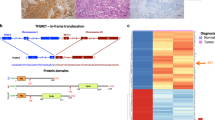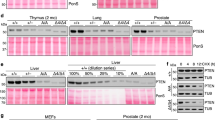Abstract
Human thyroid papillary carcinomas are characterized by rearrangements of the RET protooncogene with a number of heterologous genes, which generate the RET/papillary thyroid carcinoma (PTC) oncogenes. One of the most frequent variants of these recombination events is the fusion of the intracellular kinase-encoding domain of RET to the first 101 amino acids of a gene named H4(D10S170). We have characterized the H4(D10S170) gene product, showing that it is a ubiquitously expressed 55 KDa nuclear and cytosolic protein that is phosphorylated following serum stimulation. This phosphorylation was found to depend on mitogen-activated protein kinase (MAPK) Erk1/2 activity and to be associated to the relocation of H4(D10S170) from the nucleus to the cytosol. Overexpression of the H4(D10S170) gene was able to induce apoptosis of thyroid follicular epithelial cells; conversely a carboxy-terminal truncated H4(D10S170) mutant H4(1–101), corresponding to the portion included in the RET/PTC1 oncoprotein, behaved as dominant negative on the proapoptotic function and nuclear localization of H4(D10S170). Furthermore, conditional expression of the H4(D10S170)-dominant negative truncated mutant protected cells from stress-induced apoptosis. The substitution of serine 244 with alanine abrogated the apoptotic function of H4(D10S170). These data suggest that loss of the H4(D10S170) gene function might have a role in thyroid carcinogenesis by impairing apoptosis.
This is a preview of subscription content, access via your institution
Access options
Subscribe to this journal
Receive 50 print issues and online access
$259.00 per year
only $5.18 per issue
Buy this article
- Purchase on Springer Link
- Instant access to full article PDF
Prices may be subject to local taxes which are calculated during checkout








Similar content being viewed by others
References
Alessi DR, Saito Y, Campbell DG, Cohen P, Sithanandam G, Rapp U, Ashworth A, Marshall CJ and Cowley S . (1994). EMBO J., 13, 1610–1619.
Baron U and Bujard H . (2000). Methods Enzymol., 327, 401–421.
Bouillet P and Strasser A . (2002). J. Cell. Sci., 115, 1567–1574.
Bounacer A, Wicker R, Caillou B, Cailleux AF, Sarasin A, Schlumberger M and Suarez HG . (1997a). Oncogene, 15, 1263–1273.
Bounacer A, Wicker R, Schlumberger M, Sarasin A and Suarez HG . (1997b). Biochimie, 79, 619–623.
Butt AJ, Firth SM, King MA and Baxter RC . (2000). J. Biol. Chem., 275, 39174–39181.
Castellone MD, Cirafici AM, Vita GD, Falco VD, Malorni L, Tallini G, Fagin JA, Fusco A, Melillo RM and Santoro M . (2003). Oncogene, 22, 246–255.
Fusco A, Grieco M, Santoro M, Berlingieri MT, Pilotti S, Pierotti MA, Della Porta G and Vecchio G . (1987). Nature, 328, 170–172.
Graham FL and van der Eb . (1973). Virology, 54, 536–539.
Grieco M, Cerrato A, Santoro M, Fusco A, Melillo RM and Vecchio G . (1994). Oncogene, 9, 2531–2535.
Grieco M, Santoro M, Berlingieri MT, Melillo RM, Donghi R, Bongarzone I, Pierotti MA, Della Porta G, Fusco A and Vecchio G . (1990). Cell, 60, 557–563.
Ito T, Seyama T, Iwamoto KS, Hayashi T, Mizuno T, Tsuyama N, Dohi K, Nakamura N and Akiyama M . (1993). Cancer Res., 53, 2940–2943.
Jhiang SM . (2000). Oncogene, 19, 5590–5597.
Jossart GH, O'Brien B, Cheng JF, Tong Q, Jhiang SM, Duh Q, Clark OH and Weier HU . (1996). Cytogenet. Cell Gene, 75, 254–257.
Kulkarni S, Heath C, Parker S, Chase A, Iqbal S, Pocock CF, Kaeda J, Cwynarski K, Goldman JM and Cross NC . (2000). Cancer Res., 60, 3592–3598.
Laemli UK . (1970). Nature, 227, 680–685.
Melillo RM, Santoro M, Ong SH, Billaud M, Fusco A, Hadari YR, Schlessinger J and Lax I . (2001). Mol. Cell. Biol., 21, 4177–4187.
Mitchell KO, Ricci MS, Mivashita T, Dicker DT, Jin Z, Reed JC and El-Deiry WS . (2000). Cancer Res., 60, 6318–6325.
Mizuno T, Iwamoto KS, Kyoizumi S, Nagamura H, Shinohara T, Koyama K, Seyama T and Hamatani K . (2000). Oncogene, 19, 438–443.
Moysich KB, Menezes RJ and Michalek AM . (2002). Lancet Oncol., 3, 527–528.
Nikiforova MN, Stringer JR, Blough R, Medvedovic M, Fagin JA and Nikiforov YE . (2000). Science, 290, 138–141.
Pierotti MA . (2001). Cancer Lett., 166, 1–7.
Pierotti MA, Santoro M, Jenkins RB, Sozzi G, Bongarzone I, Grieco M, Monzini N, Miozzo A, Herrmann MA, Fusco A, Vecchio G and Della Porta G . (1992). Proc. Natl. Acad. Sci. USA, 89, 1616–1620.
Portella G, Salvatore D, Botti G, Cerrato A, Zhang L, Mineo A, Chiappetta G, Santelli G, Pozzi L, Vecchio G, Fusco A and Santoro M . (1996). Oncogene, 13, 2021–2026.
Rabes HM, Demidchik EP, Sidorow JD, Lengfelder E, Beimfohr C, Hoelzel D and Klugbauer S . (2000). Clin. Cancer Res., 6, 1093–1103.
Sakakura C, Sweeney EA, Shirahama T, Igarashi Y and Hakomais S . (1996). Int. J. Cancer, 67, 101–105.
Salvatore D, Barone MV, Salvatore G, Melillo RM, Chiappetta G, Mineo A, Fenzi G, Vecchio G, Fusco A and Santoro M . (2000). J. Clin. Endocrinol. Metab., 85, 3898–3907.
Santoro M, Melillo RM, Carlomagno F, Fusco A and Vecchio G . (2002). Ann. NY Acad. Sci., 963, 116–121.
Santoro M, Wong WT, Aroca P, Santos E, Matoskova B, Grieco M, Fusco A and Di Fiore PP . (1994). Mol. Cell. Biol., 14, 663–675.
Schlumberger M, Cailleux AF, Suarez HG and de Vathaire F . (1999). CR Acad. Sci. III, 322, 205–213.
Schwaller J, Anastasiadou E, Cain D, Kutok J, Wojiski S, Williams IR, La Starza R, Crescenzi B, Sternberg DW, Andreasson P, Schiavo R, Siena S, Mecucci C and Gilliland DG . (2001). Blood, 97, 3910–3918.
Sheils OM, O'Leary JJ and Sweeney EC . (2000). J. Pathol., 192, 32–36.
Tang D, Wu D, Hirao A, Lahti JM, Liu L, Mazza B, Kidd VJ, Mak TW and Ingram AJ . (2002). J. Biol. Chem., 277, 12710–12717.
Tong Q, Xing S and Jhiang SM . (1997). J. Biol. Chem., 272, 9043–9047.
Towbin H, Staehelin T and Gordon J . (1979). Proc. Natl. Acad. Sci. USA, 76, 4350–4354.
Tuttle RM and Becker DV . (2000). Semin. Nucl. Med., 30, 133–140.
Wang J, Knauf JA, Basu S, Puxeddu E, Kuroda H, Santoro M, Fusco A and Fagin JA . (2003). Mol. Endocrinol., 17, 1426–1430.
Viglietto G, Chiappetta G, Martinez Tello FJ, Fukunaga FH, Tallini G, Rigopoulou D, Visconti R, Mastro A, Santoro M and Fusco A . (1995). Oncogene, 11, 1207–1210.
Zhan Q, Fan S, Bal I, Guillong C, Liebermann DA, O'Connor PM and Fornace Jr AJ . (1994). Oncogene, 9, 3743–3751.
Acknowledgements
We are grateful to Massimo Santoro for helpful discussion and encouragements. We thank Corrado Garbi for his support in microscopy studies and Claudia Consales for her help in antibody purification. This study was supported by grants from the Associazione Italiana per la Ricerca sul Cancro (AIRC) and MIUR, Piano Biomedicina, Progetto 12, Cluster C04.
Author information
Authors and Affiliations
Corresponding author
Rights and permissions
About this article
Cite this article
Celetti, A., Cerrato, A., Merolla, F. et al. H4(D10S170), a gene frequently rearranged with RET in papillary thyroid carcinomas: functional characterization. Oncogene 23, 109–121 (2004). https://doi.org/10.1038/sj.onc.1206981
Received:
Revised:
Accepted:
Published:
Issue Date:
DOI: https://doi.org/10.1038/sj.onc.1206981
Keywords
This article is cited by
-
The rationale for druggability of CCDC6-tyrosine kinase fusions in lung cancer
Molecular Cancer (2018)
-
RETRACTED ARTICLE: Critical role of CCDC6 in the neoplastic growth of testicular germ cell tumors
BMC Cancer (2013)
-
Genomic analysis of a four-way t(4;11;22;10) associated with MLL-AF4 in an adult acute lymphoblastic leukemia
Annals of Hematology (2012)
-
Influence of RET/PTC1 and RET/PTC3 oncoproteins in radiation-induced papillary thyroid carcinomas on amounts of cytoskeletal protein species
Amino Acids (2011)
-
CCDC6 represses CREB1 activity by recruiting histone deacetylase 1 and protein phosphatase 1
Oncogene (2010)



